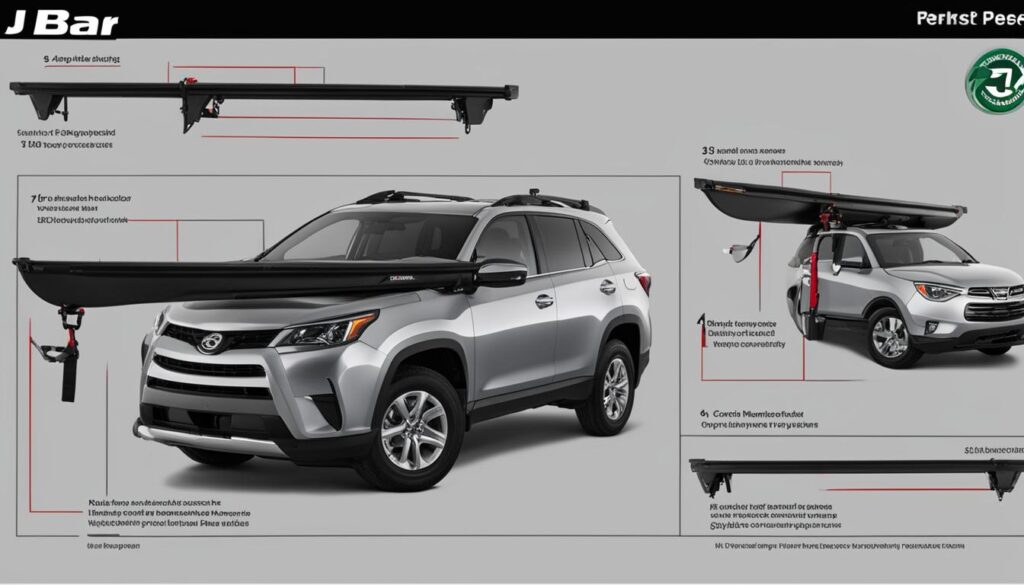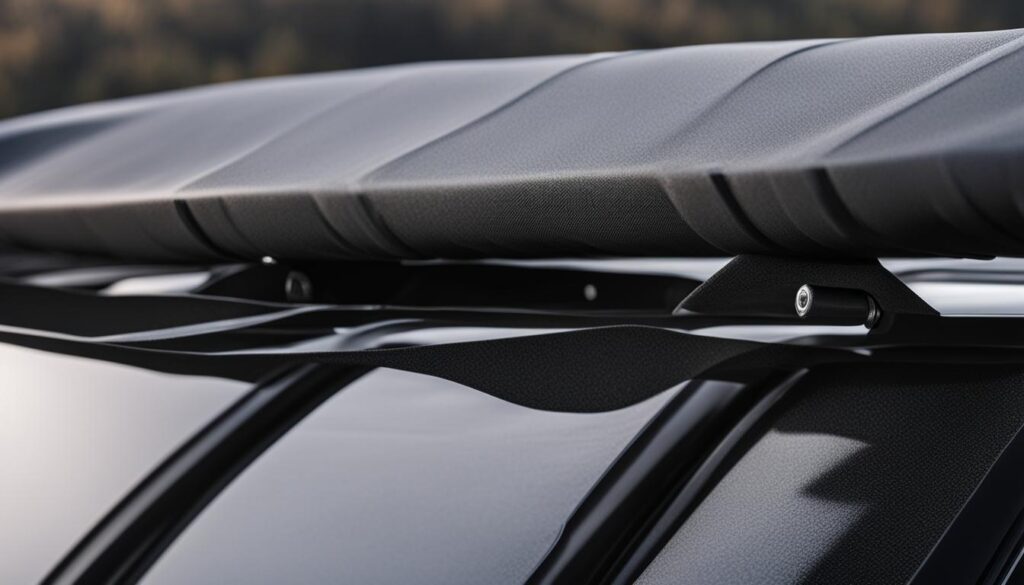Roof racks are commonly used to transport kayaks, but they can create annoying whistling or humming noises when driving at higher speeds. There’s nothing worse than a peaceful journey turning into a cacophony of sounds. The good news is that there are several effective methods to reduce roof rack noise and create a quieter and more enjoyable experience while transporting your kayak. So, let’s dive into some helpful tips that will help you minimize noise and maximize tranquility.
Key Takeaways:
- Installing J Bar Roof Racks provides a secure and stable hold for your kayak while reducing noise.
- Padding the crossbars with soft pads disrupts the airflow and decreases whistling or humming sounds.
- Fitting aerodynamic crossbars or wind fairings improves aerodynamics and minimizes wind noise.
- Building DIY wind deflectors can be a cost-effective way to reduce noise during kayak transit.
- Experiment with different noise reduction strategies to find what works best for you and enjoy a quiet and peaceful ride.
Installing J Bar Roof Racks
When it comes to securing your kayak during transit, J Bar Roof Racks are a reliable and convenient option. These racks, also known as cradle racks or J hooks, provide a secure hold and minimize noise during transportation. Installing J Bar Roof Racks is a straightforward process that can be done in a few simple steps.
To install J Bar Roof Racks, start by positioning the racks on the crossbars of your roof rack. Make sure they are aligned and centered to evenly distribute the weight of your kayak. Once in position, tighten the hooks onto the crossbars using the provided hardware. Ensure that the racks are securely fastened to prevent any movement or rattling while driving.
One of the benefits of using J Bar Roof Racks is their versatility. They can fit a range of crossbar shapes, including round, square, and oval. This makes them compatible with most roof rack systems. Additionally, J Bar Roof Racks often come with tie-down straps to provide an extra layer of security for your kayak. These straps help to further secure the kayak to the racks, ensuring a safe and worry-free journey.

Benefits of J Bar Roof Racks
There are several benefits to using J Bar Roof Racks for your kayak transportation needs. Firstly, they offer a secure and stable hold, keeping your kayak in place even during bumpy rides. This gives you peace of mind knowing that your kayak is safe and protected.
Secondly, J Bar Roof Racks help to minimize noise during transit. Their design allows for a streamlined airflow, reducing the chances of whistling or humming noises caused by wind resistance. This creates a quieter and more enjoyable journey to your paddling destination.
Lastly, J Bar Roof Racks are easy to install and remove, making them a convenient option for kayak enthusiasts. They can be quickly set up when needed and easily taken off when not in use. This versatility allows you to utilize your roof rack for other purposes when you’re not transporting your kayak.
Noise Reduction with Crossbar Padding
If you’re looking to reduce noise from your roof rack during kayak transit, one effective method is padding the crossbars. By covering the smooth metal surface of the crossbars, you can disrupt the airflow and minimize whistling or humming noises. Crossbar pads, typically used for protecting surfboards, are a great option for this purpose.
With crossbar padding, you create a softer and rounded surface on the crossbars. This change in surface shape increases the drag coefficient and reduces the noise caused by aerodynamic flow. These pads are affordable, easy to install, and can make a significant difference in noise reduction during kayak transit.
Installing crossbar pads is a simple and cost-effective solution for minimizing roof rack noise. By adding this extra layer of padding, you can enjoy a quieter and more peaceful journey while transporting your kayak.
Benefits of Crossbar Padding
Padding the crossbars not only reduces noise but also offers other benefits. Here are a few advantages of using crossbar pads:
- Protects your kayak: Crossbar pads provide a cushioning layer between your kayak and the crossbars, preventing scratches and damage during transit.
- Enhances grip: The padded surface creates a better grip, keeping your kayak securely in place even on bumpy roads.
- Increases stability: The extra padding adds stability to your kayak, reducing the chances of it shifting or moving while on the roof rack.
- Easy installation: Most crossbar pads come with a simple hook and loop closure that makes them easy to install and remove as needed.
By utilizing crossbar padding, you can not only reduce noise but also provide added protection and stability for your kayak during transportation. It’s a small investment that can greatly enhance your overall experience.

| Benefits of Crossbar Padding | Noise Reduction | Kayak Protection | Enhanced Grip | Increased Stability | Easy Installation |
|---|---|---|---|---|---|
| ✓ | ✓ | ✓ | ✓ | ✓ | ✓ |
Fitting Aerodynamic Crossbars or Wind Fairings
When it comes to reducing wind noise and improving aerodynamics during roof rack transportation, fitting aerodynamic crossbars or wind fairings is a smart choice. These accessories are specifically designed to minimize noise and create a smoother airflow around your kayak.
Aerodynamic Crossbars
Aerodynamic crossbars, also known as aero bars, are designed with a sleek and oval shape that mimics the wings of an airplane. This shape helps to reduce drag and minimize wind noise during transit. Aerodynamic crossbars often feature wind diffusion grooves, which disrupt the airflow and prevent whistle-like sounds that can be annoying and distracting.
By opting for aerodynamic crossbars, you can enjoy a quieter and more pleasant journey with your kayak. These bars are available in various sizes and can be easily installed on most roof racks.
Wind Fairings
If you’re looking for an additional noise reduction solution, wind fairings are another great option. These accessories attach to the front crossbar of your roof rack and help deflect wind away from your kayak. By redirecting the airflow, wind fairings can effectively eliminate noise caused by aerodynamic flow.
Wind fairings are particularly useful for larger kayaks or when traveling at higher speeds. They are available in different sizes and can be adjusted to fit your specific roof rack setup. With wind fairings in place, you can enjoy a quieter and more enjoyable kayak transportation experience.
Whether you choose to install aerodynamic crossbars or wind fairings, both options provide significant benefits for reducing wind noise. These accessories improve the aerodynamics of your roof rack setup, ensuring a smoother and quieter journey with your kayak. Consider incorporating these accessories into your transportation setup for a more enjoyable and peaceful experience.
Conclusion
Noise reduction for roof racks is a crucial consideration when it comes to quiet kayak transport. Implementing strategies to minimize or eliminate noise can significantly improve your overall experience during transit. By following these tips and techniques, you can ensure a peaceful and enjoyable journey:
1. Install J Bar Roof Racks
J Bar Roof Racks, also known as cradle racks, provide a secure hold for your kayak and help reduce noise. These racks are easy to install and fit various crossbar shapes. By tightly securing your kayak with J Bar Roof Racks, you can minimize the vibrations and noise caused by wind resistance.
2. Pad the Crossbars
Padding the crossbars with specialized pads disrupts the airflow and reduces roof rack noise. Crossbar pads, commonly used for protecting surfboards, create a softer and rounded surface. This change in shape increases drag and decreases the annoying whistling or humming sounds.
3. Fit Aerodynamic Crossbars or Wind Fairings
Aerodynamic crossbars and wind fairings are designed to optimize aerodynamics and reduce noise during kayak transport. Their sleek shapes and wind diffusion grooves minimize drag and prevent whistle-like sounds. By investing in these accessories, you can create a quieter and more streamlined roof rack setup.
Remember, experiment with these different noise reduction methods to find the one that works best for your specific setup. With a quieter and more peaceful journey, you can focus on enjoying the beauty of your next kayaking adventure without the distractions of roof rack noise.
FAQ
What are J Bar Roof Racks?
J Bar Roof Racks, also known as cradle racks or J hooks, are a popular option for kayak transportation. They provide a secure hold for your kayak and can be easily installed onto the crossbars of your roof rack.
How do I install J Bar Roof Racks?
To install J Bar Roof Racks, simply tighten the hooks onto the crossbars of your roof rack. They can fit a range of crossbar shapes, including round, square, and oval. J Bar Roof Racks come with mounting hardware and tie-down straps for added convenience.
How do crossbar pads help reduce roof rack noise?
Crossbar pads, typically used for protecting surfboards, can be placed on the crossbars of your roof rack to create a softer and rounded surface. This change in surface shape increases the drag coefficient and disrupts the airflow, minimizing the whistling or humming noises caused by aerodynamic flow.
What are aerodynamic crossbars?
Aerodynamic crossbars have a sleek and oval shape, similar to an airplane’s wing. They are specifically designed to reduce wind noise and improve aerodynamics during roof rack transportation. They often feature wind diffusion grooves that disrupt the airflow and prevent whistle-like sounds.
What are wind fairings and how do they help reduce noise?
Wind fairings attach to the front crossbar of your roof rack and deflect wind away from the rack. By redirecting the airflow, wind fairings eliminate noise caused by aerodynamic flow, creating a quieter and more enjoyable journey.





